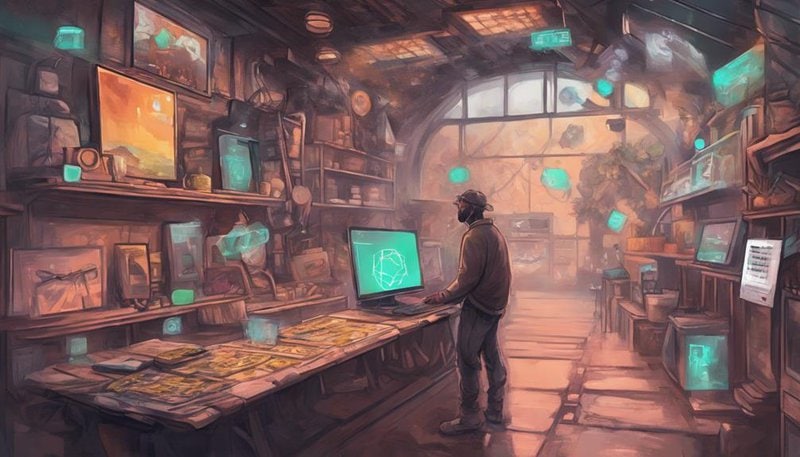How to Mint NFTs on Different Blockchains: A Comparative Guide

Creating NFTs on various blockchains involves different processes. Ethereum, the pioneering blockchain for NFTs, requires users to deploy smart contracts using platforms like OpenSea or Rarible. In contrast, Binance Smart Chain offers lower fees and faster transaction times but requires users to connect their wallets to platforms like BakerySwap or Treasureland. Solana, known for its high-speed transactions, involves minting NFTs through platforms like Magic Eden or Solsea. Each blockchain has its unique set of tools and platforms for minting NFTs, making it crucial for creators to explore and understand the process on the specific blockchain they choose.
Creating NFTs on different blockchains may require familiarity with distinct platforms, tools, and processes. Ethereum, Binance Smart Chain, and Solana are popular choices, each offering unique features and advantages for minting NFTs. Depending on the blockchain chosen, creators must navigate the specific tools and platforms available to mint their digital assets successfully. Understanding these differences can help creators select the most suitable blockchain for their NFT projects and navigate the minting process effectively.
Key Takeaways
- Ethereum and Binance Smart Chain offer diverse NFT minting options.
- Solana and Polkadot provide unique features for NFT creation.
- Tezos and Flow Blockchain present user-friendly NFT minting experiences.
- Avalanche, Tron, EOS, and Stellar offer varied NFT minting opportunities.
Ethereum NFT Minting Process
To mint an NFT on the Ethereum blockchain, you need to interact with a smart contract through a decentralized application (dApp) that facilitates the creation and ownership transfer of unique digital assets. Ethereum, as a pioneer in the NFT space, follows specific token standards like ERC-721 and ERC-1155. These standards ensure that your NFT is compatible with various marketplaces and wallets, enhancing its liquidity and transferability.
The NFT creation process on Ethereum involves defining your asset, whether it's art, music, collectibles, or any digital item you want to tokenize. Once you have your digital asset ready, you can choose a platform or marketplace that supports Ethereum NFTs. Connecting your wallet to the dApp, you then interact with the smart contract to create your NFT. This process embeds your unique digital asset's information into a token that's stored securely on the Ethereum blockchain, giving you proof of ownership and authenticity.
Understanding token standards and the NFT creation process on Ethereum empowers you to participate in the exciting world of digital ownership and decentralized creativity.
Binance Smart Chain NFT Minting
When minting NFTs on the Binance Smart Chain, you engage with a different ecosystem for creating and transferring unique digital assets. The Binance Smart Chain offers a streamlined approach to minting NFTs, making it an attractive option for creators looking to harness its efficiency and cost-effectiveness.
Here are some key aspects to consider when delving into Binance Smart Chain NFT minting:
- Low Fees: Transactions on the Binance Smart Chain are known for their low fees, making it a wallet-friendly option for minting NFTs.
- Fast Transaction Speeds: The Binance Smart Chain boasts rapid transaction speeds, allowing for quick minting and transfer of NFTs.
- NFT Marketplace Integration: Binance Smart Chain supports integration with various NFT marketplaces, providing a seamless way to list and sell your digital assets.
- Interoperability: The Binance Smart Chain promotes interoperability, enabling cross-chain compatibility for your NFTs to reach a wider audience.
Solana NFT Minting Steps

Exploring Solana for minting NFTs introduces a dynamic ecosystem with unique opportunities for creating and exchanging digital assets. To start your Solana NFT minting journey, you'll need to leverage specific NFT minting tools designed for the Solana blockchain. These tools streamline the minting process, making it efficient and user-friendly.
When minting NFTs on Solana, you can utilize platforms like Metaplex, a popular choice among creators for its seamless minting interface and robust features. Metaplex allows you to mint NFTs with customizable attributes, ensuring each digital asset is unique and truly one-of-a-kind.
Additionally, you can explore other Solana-based NFT minting tools such as Candy Machine, providing a straightforward way to mint NFTs and manage your digital collections. By utilizing these tools, you can tap into Solana's high-speed and low-cost network to mint and trade NFTs with ease.
Embrace the innovative Solana ecosystem for your NFT minting endeavors, and leverage the available tools to bring your creative vision to life in the digital realm.
Polkadot NFT Minting Guide
Let's navigate through the Polkadot NFT minting process together, focusing on the key requirements for minting on this blockchain.
Understanding the steps and prerequisites will empower you to create and showcase your unique NFTs in the Polkadot ecosystem.
Stay tuned for essential insights to kickstart your NFT minting journey on Polkadot.
Polkadot NFT Process
Embark on the journey of minting NFTs on the Polkadot blockchain with this comprehensive guide.
Navigating the Polkadot NFT creation process can be rewarding and straightforward. Here are some key steps to guide you through this exciting journey:
- Understand Polkadot NFT Standards: Familiarize yourself with the specific NFT standards supported on the Polkadot network.
- Choose a Polkadot-Compatible Wallet: Select a trusted wallet that supports Polkadot to store your NFTs securely.
- Connect to a Polkadot NFT Marketplace: Integrate your NFTs with a Polkadot marketplace for visibility and potential sales.
- Execute the Minting Process: Follow the platform's instructions to mint your NFTs successfully on the Polkadot blockchain.
Key Minting Requirements
Embark on the next phase of your Polkadot NFT journey by understanding the essential key minting requirements for a successful NFT minting process.
To mint NFTs on Polkadot, you must adhere to specific minting criteria and NFT standards. These include providing unique metadata for your NFT, ensuring compliance with Polkadot's technical specifications, and paying attention to gas fees for the minting process.
Additionally, you need to connect your wallet to a Polkadot-compatible platform, such as a decentralized marketplace, to facilitate the minting and trading of your NFTs.
Tezos NFT Minting Tutorial

So, you're ready to explore the world of Tezos NFT minting. Understanding the basics and steps involved in the minting process is crucial for your journey.
Let's unravel the Tezos NFT world together, starting with the fundamentals and moving on to the practical steps.
Tezos NFT Basics
Delve into the realm of Tezos NFT basics, where the process of minting unique digital assets takes center stage. Here are some key points to help you understand the world of Tezos NFT creation and the Tezos NFT marketplace:
- Tezos NFT Creation: Discover how to create your own non-fungible tokens on the Tezos blockchain.
- Tezos NFT Marketplace: Explore where you can buy, sell, and trade Tezos-based NFTs.
- Smart Contracts: Learn about the use of smart contracts in Tezos NFT minting.
- Interoperability: Understand how Tezos NFTs can interact with other blockchain platforms for increased utility and flexibility.
With this foundational knowledge, you'll be better equipped to navigate the exciting realm of Tezos NFTs.
Minting Process Steps
Begin your Tezos NFT minting journey by understanding the essential steps in the minting process for creating unique digital assets on the Tezos blockchain.
When minting NFTs on Tezos, start by comparing minting software options. Evaluate factors like user-friendliness, security features, and community support to select the most suitable software for your needs.
Next, delve into NFT tokenomics analysis to determine the pricing, scarcity, and utility of your NFTs. Consider the demand for your digital collectibles and set a fair value that aligns with their uniqueness and market trends.
Flow Blockchain NFT Minting
When venturing into the realm of minting NFTs on the Flow Blockchain, understanding the unique features and processes specific to this blockchain is crucial for a successful experience. The Flow blockchain offers a distinct approach to NFT minting compared to other blockchains. Here are some key points to consider:
- Flow Blockchain Ecosystem: Explore the Flow blockchain ecosystem to understand how NFTs fit within its structure.
- Cadence Smart Contracts: Utilize Cadence, the programming language for Flow, to create powerful smart contracts for NFT minting.
- User-Friendly Interface: Benefit from the user-friendly interface of the Flow blockchain, making NFT minting accessible to a wider audience.
- High-Performance Scalability: Leverage Flow's high-performance scalability, ensuring efficient and fast transactions for minting NFTs.
Avalanche NFT Minting Overview

Explore the fascinating world of Avalanche NFT minting, where digital assets find a secure and efficient home on this innovative blockchain platform. The Avalanche NFT ecosystem offers a promising space for creators and collectors to engage in the thriving world of non-fungible tokens. One of the key highlights of Avalanche is its focus on addressing interoperability challenges, allowing NFTs minted on this platform to seamlessly interact with other blockchain networks.
By leveraging Avalanche's high-performance infrastructure, NFT minting becomes not only a straightforward process but also a sustainable one. The platform's low transaction fees and lightning-fast speeds ensure a smooth minting experience for users, making it an attractive option for those seeking efficiency and cost-effectiveness in minting their digital assets.
In the dynamic landscape of NFTs, Avalanche stands out for its commitment to enhancing interoperability and providing a robust foundation for the growth of the NFT market. Embrace the opportunities presented by the Avalanche NFT ecosystem and embark on your journey into the world of digital collectibles with confidence.
Tron Blockchain NFT Minting
Embark on a journey of creativity and innovation by minting NFTs on the Tron blockchain, where digital assets can flourish in a vibrant and decentralized environment.
- Tron Blockchain NFT Marketplace: Explore the diverse range of NFT marketplaces on the Tron blockchain, offering unique opportunities to showcase and trade your digital creations.
- Tron NFT Token Standards: Familiarize yourself with TRC-721 and TRC-1155, the two primary NFT token standards on the Tron blockchain, ensuring compatibility and interoperability.
- Decentralized Ecosystem: Immerse yourself in Tron's decentralized ecosystem, where artists and collectors interact directly, fostering a sense of community and empowerment.
- Low Transaction Costs: Benefit from the Tron blockchain's low transaction costs, enabling cost-effective minting and trading of NFTs without compromising on security or efficiency.
Unlock the potential of your digital creations by leveraging the Tron blockchain's robust infrastructure and vibrant community, where innovation knows no bounds.
EOS NFT Minting Explained

Embarking on the journey of understanding EOS NFT minting unveils a world of innovation and opportunity.
You'll explore the specific standards that EOS adheres to for minting NFTs and gain insight into the meticulous steps involved in the minting process.
Discovering the intricacies of EOS NFT minting is a gateway to unlocking the potential of this blockchain for your creative ventures.
EOS NFT Standards
In the realm of blockchain technology, EOS NFT standards offer a unique framework for minting non-fungible tokens, providing creators with a diverse array of possibilities for their digital assets.
When exploring EOS NFT standards, consider the following:
- Interoperability: EOS NFTs can be easily exchanged and utilized in various ecosystems.
- Scalability: The EOS blockchain can handle a high volume of transactions, ensuring efficient NFT minting processes.
- Community Support: The EOS community actively engages with NFT creators, fostering a collaborative environment.
- Smart Contract Capabilities: EOS smart contracts enable intricate NFT functionalities, enhancing the token's utility.
Understanding these aspects can help you leverage the full potential of EOS NFT standards in your creative endeavors.
Minting Process Steps
Exploring the intricacies of minting EOS NFTs involves a step-by-step process that unlocks the potential of your digital assets in the blockchain ecosystem.
To start, prepare your digital art or content for minting by ensuring it meets EOS NFT standards.
Next, select a minting platform that supports EOS, keeping in mind the minting fees comparison across different platforms to optimize your costs.
Once your assets are ready, initiate the minting process on the chosen platform by following their specific guidelines.
Finally, consider NFT marketplace integration to showcase and sell your newly minted EOS NFTs to a wider audience.
Stellar NFT Minting Walkthrough
Begin your journey into the world of Stellar NFT minting by mastering the essential steps outlined in this walkthrough. When it comes to Stellar NFT creation, the process involves specific steps to ensure a successful minting experience on the Stellar blockchain. Here are the key actions you need to take:
- Set Up a Stellar Wallet: Before diving into NFT minting, ensure you have a Stellar wallet to store your assets securely.
- Acquire XLM: You'll need XLM, the native cryptocurrency of the Stellar network, to cover transaction fees.
- Choose a Stellar NFT Marketplace: Select a platform compatible with Stellar for minting and showcasing your NFTs.
- Upload Your NFT Content: Prepare your digital artwork or collectibles for minting by uploading them to the chosen marketplace.
Frequently Asked Questions
Can NFTs Minted on Different Blockchains Be Easily Transferred or Traded Across Platforms?
Yes, NFTs minted on different blockchains can be easily transferred or traded across platforms. Cross-chain compatibility and blockchain interoperability enable seamless token portability, facilitating inter-platform trading and expanding the reach of digital assets.
How Does the Cost of Minting NFTs Vary Between Different Blockchains?
To understand the cost comparison and minting efficiency across different blockchains, you'll find that fees vary based on network congestion and token standards. Choose wisely, as each blockchain offers unique advantages that impact your NFT creation journey.
Are There Any Specific Requirements or Limitations for Minting NFTs on Certain Blockchains?
When minting NFTs on specific blockchains, you might encounter unique requirements or limitations. These can include verification processes, gas fees, and smart contract implementation. Understanding these nuances is crucial for a successful minting process.
What Are the Key Factors to Consider When Choosing Which Blockchain to Mint NFTs On?
When choosing a blockchain to mint NFTs, consider scalability options for future growth and robust security features to protect your assets. These factors play a vital role in ensuring your NFTs are successful and secure.
How Does the Environmental Impact of Minting NFTs Differ Between Various Blockchains?
When considering the environmental impact comparison of minting NFTs on different blockchains, it's vital to conduct an energy consumption analysis. Understanding how each blockchain operates can help you make a conscious choice that aligns with your values.








